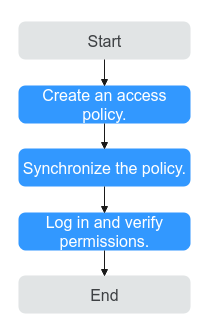Using the AccessPolicy API to Manage Namespace Permissions (Kubernetes RBAC-based)
Prerequisites
- Before assigning permissions to users or user groups, you need to review the information provided in Namespace Permissions (Kubernetes RBAC-based).
- To use an access policy, an IAM user or user group must have the specific permissions. These include CreateAccessPolicy, UpdateAccessPolicy, DeleteAccessPolicy, ListAccessPolicy, and GetAccessPolicy. Learn about the CCE system policies that can be added to a user group and select appropriate ones as needed. For details about how to assign permissions to a user group, see Granting Cluster Permissions to an IAM User.
Configuring Namespace Permissions Through APIs
You can regulate users' or user groups' access to Kubernetes resources in a single namespace based on their Kubernetes RBAC roles. Users with the configuration permission can configure access policies through APIs.

- Call the API to create an access policy.
POST /api/v3/access-policies
Request body:
{"kind": "AccessPolicy","apiVersion": "v3","name": "policy-test","clusters": [ "*" ],"accessScope": {"namespaces": [ "ns1", "ns2" ]},"policyType": "CCEAdminPolicy/CCEClusterAdminPolicy/CCEEditPolicy/CCEViewPolicy","principal": {"type": "user/group/agency","ids": ["id1", "id2" ]}}Parameter
Item
Description
name
Name
Name of the access policy.
clusters
Cluster list
IDs of the clusters to which access policies are to be added. Wildcard characters (*) are supported.
namespaces
Namespaces
Namespaces to which access policies are to be added. Wildcard characters (*) are supported.
policyType
Permission type
Permission type. Options:
- CCEClusterAdminPolicy: administrator permission
- CCEAdminPolicy: O&M permission
- CCEEditPolicy: developer permission
- CCEViewPolicy: read-only permission
principalType
User or user group type
Type of a user or user group. Options:
- user: user
- group: user group
- agency: agency account
principalId
User or user group list
IDs of the users or user groups to be authorized.
- The CCE management plane automatically synchronizes the access policies to the associated cluster. Run the kubectl command. Then, RoleBinding or ClusterRoleBinding will be created in the cluster.Note
The synchronization will take several minutes to take effect.
- Check RoleBinding in the cluster.kubectl get rolebinding
In the following command output, clusterrole_access_policy_069fcc2116c347b89869eae3cd38ba23 is the automatically created RoleBinding:
NAME ROLE AGEclusterrole_access_policy_069fcc2116c347b89869eae3cd38ba23 ClusterRole/admin 18s - Check RoleBinding details.kubectl get rolebinding clusterrole_access_policy_069fcc2116c347b89869eae3cd38ba23 -oyaml
Command output:
apiVersion: rbac.authorization.k8s.io/v1kind: RoleBindingmetadata:annotations:CCE.com/IAM: "true"label:rbac.kubernetes.io/GeneratedByAccessPolicy: "true"creationTimestamp: "2021-06-24T01:30:08Z"name: clusterrole_admin_group0c96fad22880f32a3f84c009862af6f7resourceVersion: "36963685"selfLink: /apis/rbac.authorization.k8s.io/v1/namespaces/default/rolebindings/clusterrole_admin_group0c96fad22880f32a3f84c009862af6f7uid: 6c6f46a6-8584-47da-83f5-9eef1f7b75d6roleRef:apiGroup: rbac.authorization.k8s.iokind: ClusterRolename: adminsubjects:- apiGroup: rbac.authorization.k8s.iokind: Groupname: 0c96fad22880f32a3f84c009862af6f7
- Check RoleBinding in the cluster.
- Log in to the CCE console as the newly authorized IAM user for verification.
In the service list, choose Cloud Container Engine. On the CCE console, access the cluster and choose the target namespace. If only the default namespace is authorized and the kube-system namespace is unavailable, the access policy has taken effect.
- Prerequisites
- Configuring Namespace Permissions Through APIs